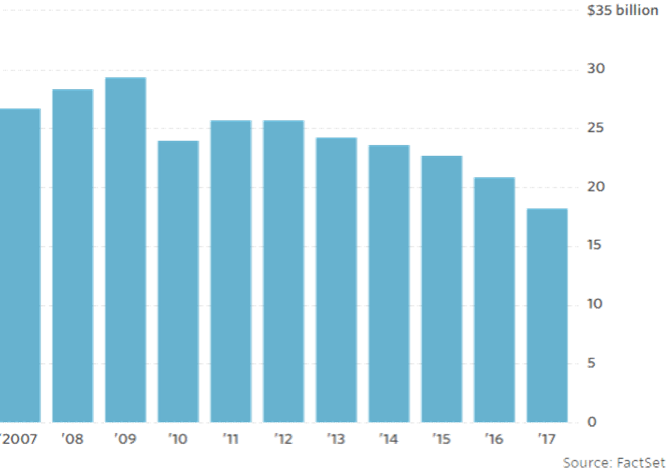Why iText and Blockchain?
When iText was first released in the year 2000, its author, Bruno Lowagie, wrote down the following mission statement:
We want to enable the paperless world,
pushing the limits of digital document interactivity!
With iText, we wanted to replace paper-based workflows with a workflow involving digital documents. We wanted to accomplish this by emphasizing the added value of digital over paper. Today, this mission seems almost accomplished:
Digital invoices are legally binding in many countries,
On January 1, 2023, the National Archives and Records Administration (NARA) will stop accepting paper documents: all transferred permanent or temporary records to the National Archives and Records Administration must be in electronic format.
Printer use is dropping significantly, as shown in figure 1.

Figure 1: HP printing revenue
The Dematerialization of the Document
At the same time, we see another evolution. We thought that PDF was here to stay, but when boarding a plane, we stopped using paper boarding passes, many of us are using a two-dimensional bar code in an app. When we make a purchase using an app, we often pay without receiving an invoice as a document; often it's merely data presented to us in an app. The mentality towards documents is changing:
In the past, users didn't trust a digital document that didn't look like a paper document,
The mobile web changed this mentality: content can look differently, but still have the same validity.
While we're still working on the further dematerialization of paper, we notice the beginning of the dematerialization of the document. As shown in figure 2, we're evolving from paper documents to digital document, and from digital documents to responsive content.

Figure 2: dematerialization of paper / dematerialization of documents
As we are in the document business, the dematerialization of the document could pose a threat for our industry. Fortunately, we have some ideas to turn this threat into an opportunity.
How to turn a threat into an opportunity?
First of all, there are some known flaws with respect to data served to apps:
Reliability: was the data presented correctly?
Immutability: what if the data in the database changes (deliberately or undeliberately)?
Security: who has access to the data?
We also aren't blind to some known flaws in PDF:
It's difficult to unlock data from a PDF that isn't created in an accessible way. We can solve this using tools, but it's not always trivial to extract data from a PDF in a reliable way.
Digital signatures are a pain: signatures need to be applied sequentially, you need a Certificate Authority (CA) and a Timestamp Authority (TSA), not all viewers support signatures (Preview, mobile viewers,...), and so on.
By working on solutions for these flaws, we can adapt to the new situation, and create new business by investing in new technologies:
Next-Generation PDF
We aren't the only company in the document industry who has noticed the evolution of the dematerialization of the document. As a member of the PDF Association, we've joined forces with several other companies to develop a new specification that is currently codenamed Next-Generation PDF. Next-Generation PDF will marry core PDF capabilities to the flexibility of web technologies. Next-Generation PDF should also emphasize the value of PDF as a data container.
Distributed Ledger Technology and Blockchain
Blockchain is a distributed database that serves as an irreversible and incorruptible repository for permanent records. While studying the concepts of distributed ledger technology, we discovered that Blockchain could solve some of the issues that are inherent to digital signatures in PDF. Based on our research, we filed a series of patents describing mechanisms that we are now developing together with different partners.
What's the market?
Moody's Investors Service (MIS) released a report “Credit Strategy -- Blockchain Technology: Robust, Cost-effective Applications Key to Unlocking Blockchain's Potential Credit Benefits” identifying 25 top blockchain use cases, from a list of 120.

Figure 3: Selected potential Blockchain Use Cases (source: Moody’s Investors Service)
By tapping into that market, we can turn a threat for our business into an opportunity.
